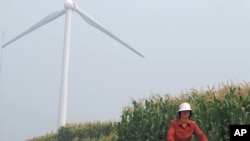The International Energy Agency recently said China has become the world's biggest energy consumer - surpassing the United States. While Beijing disputes the IEA findings, claiming its calculations are misleading, China says it is leading the world in green energy investment and production.
The huge turbines at the Guanting Wind Farm are popular backdrops for photos of newly married couples who find the 60-meter-tall structures a symbol of modernity; an endearing addition to the distant mountains, corn fields and lake a few dozen kilometers outside bustling Beijing.
The hum of the spinning blades is the sound of China going green as it seeks to address the growing energy demands of its rapidly modernizing consumer society and fast-paced industrialization.
China was angered when the International Energy Agency recently named the country the world's biggest energy user and emitter of carbon dioxide.
Biased report?
A leading researcher at China's National Development and Reform Commission Energy Research Institute, Hu Xiulian says the IEA's statistics are unreliable and biased.
Hu says Chinese statistics prove China is not yet the world's largest energy user. She cites oil consumption figures as an example that contradict the IEA's findings.
But International Energy Agency Chief Economist, Fatih Birol, denies bias in the agency's calculations.
"We included the same data for all countries; we follow the U.N. agreed conventions and definitions," Birol explained. "This is data under primary energy sources of all the countries. We have no problem whatsoever with any country arguing about the numbers."
Vast consumption
There is no denying hundreds of millions of Chinese are buying homes, refrigerators, TV sets, vehicles and other energy-hungry trappings of a consumer society. It is routinely reported China relies heavily on cheap and widely available coal, the main resource that creates the rising carbon dioxide levels blamed for global warming and other environmental damage.
But only one third of China's vast population is enjoying a modern lifestyle; hundreds of millions more consumers will be demanding energy in the years ahead.
China is building hundreds of coal-powered energy plants each year. Coal fuels 70 percent of China's energy consumption, making the country the largest consumer and producer of coal in the world.
Beijing has refused to agree to cap its overall growth in its consumption of fossil fuels or reduce its emissions of carbon dioxide and other greenhouse gases.
That frustrated U.S. President Barack Obama and other world leaders' efforts to forge an international climate agreement at a U.N. summit in Copenhagen last December.
Renewable sources
But the world's most populous nation is also a leader in renewable energies.
Global research company REN 21 - a network of governments, non-government organizations, and industry associations - reports China's total wind power doubled for the fifth year in a row in 2008, ending that year producing 12 gigawatts and passing its 2010 development target of 10 gigawatts two years early. Solar and water power generation are also being rapidly expanded.
The IEA's Birol agrees that when it comes to going green, China is another world leader.
"I am following the energy policies of almost all the big countries of the world, and there is no other government which is as dynamic as the Chinese government in putting energy policies in place," Birol said.
Guanting Wind Farm security supervisor Zong Minqiang says all the power produced on the farm makes up one-tenth of Beijing's electricity needs.
Zong says the farm was constructed to help clean up Beijing for the 2008 Olympics. He says the farm helps ease Beijing's reliance on dirty energy that creates the capital's notorious smog.
Stimulus package
In the wake of the global financial crisis, the Chinese government earmarked 14.5 percent of a $586-billion stimulus package to energy saving and green investments.
China has also attracted record investments from overseas companies in the past two years.
Yet traveling back to smog-bound Beijing, past industrial factories, high-rise apartment blocks under construction, shopping malls and the ever growing number of cars, the future once more looks uncertain.
How, one asks, will the government satisfy the energy demands resulting from the rising expectations of its 1.3 billion, consumer-hungry people? A small part of the answer is already blowing in the wind. But burning questions remain.
China Working Toward Green Energy Solutions









